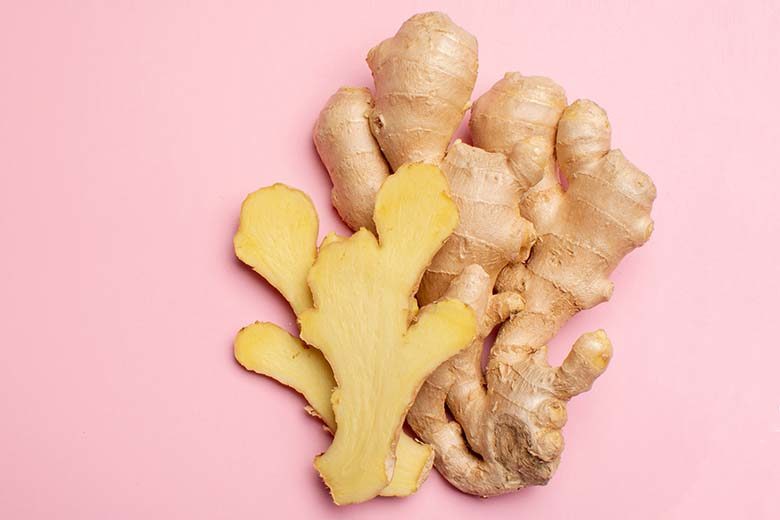
Ginger comes from a flowering plant and is in the same family as cardamom and turmeric. Native to Asia, ginger has long been used in China, India and Japan as a medicine to treat stomach aches, nausea and diarrhea. A common use of ginger is to relieve nausea and vomiting associated with motion sickness, surgery and pregnancy. Ginger also has been used for rheumatoid arthritis, osteoarthritis and joint and muscle pain, as it is believed to have some anti-inflammatory properties. It also is used as a spice to flavor food, adding a piquant flavor, texture and aesthetic appeal.
Ways to consume ginger are fresh or dried ginger root, tablets, capsules, liquid extracts (tinctures), fresh ginger root tea, ginger tea packets, ginger candies and crystallized ginger. Ginger ale, ginger beer or ginger snaps contain some ginger, but they most likely will not offer an amount needed to be therapeutic and often are sources of added sugars.
In the Kitchen: For culinary use, ginger is sold fresh, dried as powder, pickled in vinegar, preserved and candied. Dried ginger is mainly used in baking, such as in ginger snaps and gingerbread. Pickled ginger is used as a relish or garnish, while preserved and candied ginger are eaten as confections. Fresh ginger imparts a very different flavor and is often usedin fruit salad, curries, stir-fried dishes and more.
Most Asian grocery stores sell young fresh ginger, which has a pale, thin skin that doesn’t need peeling. However, large supermarkets usually sell mature ginger (also known as raw ginger) with a tough outer skin that needs to be peeled. Look for smooth skin — not dried or wrinkled — and use a metal teaspoon to peel the root instead of a knife.
Fresh ginger can be sliced, grated or minced with a garlic press and used in soups, stews, curries, chutneys, salads, condiments, stir-fried dishes or teas. You also can extract juice from the root to use in salad dressings, marinades or beverages such as lemonade or iced tea.
In the Clinic: Few side effects are linked to ginger when taken orally in small doses. Reported side effects have included abdominal discomfort, heartburn and nausea, which have been reported most often with powdered ginger.
Results from clinical trials suggest that ginger may be effective as a short-term antiemetic agent for pregnancy-related nausea and vomiting, although it has been shown to be less effective than antiemetic prescription medication. When used as an extract, some patients have reported improvement in pain related to osteoarthritis. However, it is not clear whether ginger is effective in treating rheumatoid arthritis or joint and muscle pain. The majority of evidence has shown that taking ginger does not help to prevent or treat motion sickness, and its safety when used for medicinal purposes while breastfeeding has not been determined.
There also are inconsistent findings on the effectiveness of ginger in reducing or delaying chemotherapy-associated nausea. Its benefit may depend on the chemotherapy regimen, whether other antiemetic medications are taken and the form and dose of ginger used.
Some evidence suggests ginger could be helpful for patients or clients who are not benefitting from other nausea-reducing medications or as an adjunct to conventional therapies. However, ginger may interact with other medications or supplements and be contraindicated with certain conditions or treatments, such as prior to surgery.
In Quantity: Powdered or crystallized ginger is especially useful for large-batch recipes such as in foodservice. While using fresh ginger may seem like a daunting task, it is used in institutional and commercial kitchens across the country.
Some major food distributors sell ginger for quantity, either fresh, pureed, minced, diced or as gari, also known as sushi ginger, which is pickled. Although processed fresh ginger is useful, many cooks prefer to prepare their own fresh ginger to achieve desired texture or flavor characteristics for their menu items.
To process fresh ginger, wash it and remove woody ends and stems. It does not have to be peeled. The ginger can be put through a food processor, blender or buffalo chopper for desired consistency. If the processed ginger will be stored in a refrigerator for a few days, add vinegar to reduce oxidation.
References
Ginger Dietary Supplement Fact Sheet. National Institutes of Health, National Center for Complementary and Integrative Health website. https://www.nccih.nih.gov/health/ginger. Accessed February 17, 2022.
Ginger Professional Monograph. Natural Medicines Database website. https://naturalmedicines.therapeuticresearch.com/databases/food,-herbs-supplements/professional.aspx?productid=961. Accessed February 17, 2022.
Gordon D, Duyff RL, Lafferty L. (2007, January/February). Love Food: Ginger. ADA Times, Volume 4, Issue 2, 16-17.
Supherb Farms 1/8 inch Diced Ginger, 5 Pound. FoodServiceDirect.com website. https://www.foodservicedirect.com/supherb-farms-1-8-inch-diced-ginger-5-pound-1-each-23004337.html. Accessed February 18, 2022.
Sushi ginger. Roland website. https://rolandfoods.com/product/60364-sushi-ginger. Accessed February 18, 2022.
